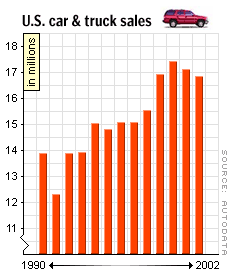DETROIT (CNN/Money) - The U.S. auto industry just completed a year that, until recently, would have been cause for celebration. But today it's cause for concern.
The 16.8 million light vehicles sold in 2002 would have been a record before 1999. But it ended up being 2 percent off year-earlier sales, and projections are that 2003 will bring the third straight year of decline.
The U.S. industry paid for the strong sales with heavy incentives such as zero-interest financing deals that show no signs of going away and low pricing that shows little ability to climb.

Besides the tough sales environment, the traditional Big Three U.S. automakers face possibly contentious labor negotiations with the United Autoworkers union, deep underfunding in pension plans at General Motors Corp. and Ford Motor Co. due to recent stock market declines, and the possibility of an oil price shock if there is a prolonged war with Iraq.
So, as industry executives gather in Detroit this week for the annual North American International Automobile Show, there's a lot of reason for worry.
A survey of 100 top industry executives by accounting and consulting firm KPMG LLP found that whereas a year ago most executives believed they would see a return to 2000 profit levels by 2003 or 2004, today they're not looking for a return to that level of profits until 2005 at the earliest.
A bit more than half the executives expect the Big Three to continue to lose market share, and only 11 percent expect to see any market share gain by GM, Ford or DaimlerChrysler's Chrysler Group over the next five years. That's about half the percentage that were looking for gains a year ago.
The Big Three's share of the U.S. sales market fell to 61.7 percent in 2002 from 63.3 percent in 2001, even though GM picked up about 0.3 percentage points of share. As recently as 1999 the three had more than 70 percent of the market.
"I think they have some very difficult challenges over the next three years," said Brian Ambrose, national industry director of KPMG's Automotive practice. "The silver lining is if they continue to reduce costs and strive for flexible manufacturing, they can see a return to profits even without the sales levels of 2000. But the Asian brands and European brands aren't sitting still either."
Greater base demand for autos
One factor working in the industry's favor is that the U.S. appetite for new cars appears to be greater than ever. Industry experts and analysts say that a "normal" year is now probably about 16.5 million new cars and light trucks, which includes pickups, minivans and sport/utility vehicles. That's nearly 1 million more than industry sales in 1998, which was the best sales year of the decade up to that point.
But low prices and expensive incentives are part of the reason for that new appetite for new cars. Average car prices as a percent of average household income is at a record low, putting the squeeze on profits.
GM and Ford executives say they're now looking at 2003 sales to be a little below that 16.5 million level, although estimates at the last three Detroit auto shows all came in on the low side. But analysts question whether even low prices and strong incentives will be enough to keep consumers buying if there is another Gulf war and continued struggles by the U.S. economy.
"Car buying is influenced by consumer confidence," Merrill Lynch auto analyst John Casesa told CNNfn last week. "And confidence varies month to month but on a trend basis, it is down a lot in the last year, year-and-a-half. And my own view, unless it bounces back and unless history is wrong, we're going to really struggle to get these buyers in next year because they're just not as confident about the future to make a big ticket purchase as they were six months or a year ago."
Labor talks, pensions loom
As if there weren't enough clouds on the horizon, this fall the UAW contracts expire at the Big Three. While it's unlikely management will be seeking wage cuts, they have long ago signaled that their demands will be difficult for the union to swallow -- such as plant closings and more employee and retiree contributions to health care costs.
The current contracts make it difficult to close U.S. plants because laid-off hourly workers remain on almost full-pay. But Ford and Chrysler have announced cost-cutting and plant closing plans for after the expiration of the contract. And salaried workers have been asked to shoulder a bigger portion of their health care costs.
Still some industry analysts believe a crippling strike is unlikely, even if management demands are distasteful to the UAW.
"I think the chance of that (a strike) is about zero," said Chris Struve, analyst for auto industry for credit rating agency Fitch. "The union guys are realizing the health of their jobs is intertwined with the health of their companies. Both sides are going to realize they have to work together."
Struve said the bigger labor problem facing GM and Ford is what to do about massive underfunding in their pension funds. GM has already announced it is selling its defense business in an effort to raise cash to help make contributions. Struve said that he would expect GM to make a $4 billion to $6 billion contribution to the fund this year, while he says Ford is likely to make a $500 million contribution.

|

